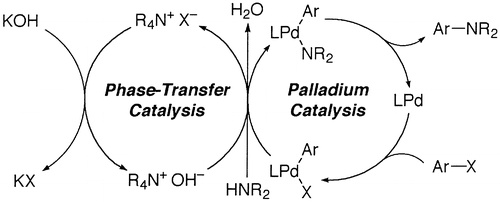Aqueous hydroxide as a base for palladium-catalyzed amination of aryl chlorides and bromides

The amination of aryl halides in the presence of inexpensive and air-stable alkali metal hydroxide bases and Pd[P(t-Bu)3]2 as catalyst gave arylamines in high yields. The reactions were conducted with a catalytic amount of cetyltrimethylammonium bromide as phase-transfer agent and either aqueous hydroxide or solid hydroxide in the presence of water. This combination of alkali metal hydroxide base, H2O, and the ammonium salt performed as well as NaO-t-Bu in the amination of p-chlorotoluene with dibutylamine. Hydroxide base was suitable for reactions of a wide range of aryl chlorides and bromides with aliphatic and aromatic amines. Some functional groups that were intolerant of tert-butoxide base, such as esters, enolizable ketones, nitriles, and nitro groups, were tolerated by the combination of hydroxide base, H2O, and cetyltrimethylammonium bromide in toluene solvent.
Read more on publisher's site.